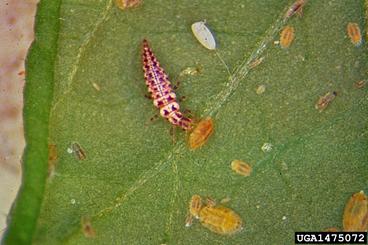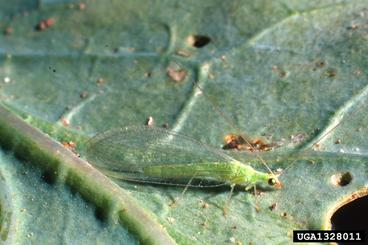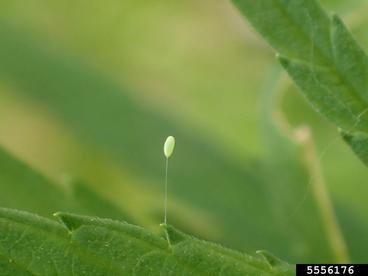M.A. Carrillo1, S.W. Woolfolk2 and W.D. Hutchison1
1 Department of Entomology, University of Minnesota
2 Department of Entomology and Plant Pathology, Mississippi State University
Introduction

The green lacewings, Chrysoperla carnea (Stephens) and Chrysoperla rufilabris (Burmeister), are commonly found throughout North America. Interest in utilizing these beneficial predators as a component of Integrated Pest Management (IPM) programs, for field and horticultural crops, has recently increased as growers seek alternatives to insecticides for managing insect pests. Some green lacewing species are also known to exhibit tolerance or resistance to insecticides, which also makes the predator more compatible with most IPM systems. Green lacewing larvae, also known as "aphid lions", possess excellent searching qualities, exhibit high dispersal ability, and are particularly active against aphid pests. Their role is very important when other aphid predators are not active. They are voracious predators of a wide variety of soft-bodied arthropods including insects (e.g., aphids, caterpillars, leafhoppers, psyllids, white flies, and thrips), insect eggs, spiders and mites. Adults are not carnivorous and feed primarily on honeydew, pollen and nectar of flowers. Since green lacewings are generalists, the proper use of this predator is essential for a positive effect within IPM programs.
Description

Green lacewings are typically ¾ inch long, have long netlike wings, slender pale green bodies, and golden eyes. Eggs are green, oval-shaped, and attached to the end of a hair-like filament.
Larvae are "alligator" shaped, with long, forcep-like, curved tubular mandibles, and have colorations ranging from grey to brown. The pupa is formed inside a spherical silken cocoon that is attached to vegetation.
Agroecosystem
Worldwide, several species of Chrysoperla spp. have been found associated with 19 field crops, 21 tree crops, and numerous forestry and horticultural plants. Augmentative releases of C. carnea and C. rufilabris in North America have been reported on many crops including cotton, soybean, potato, broccoli, sugar beets, apple, pears, grape and various ornamentals. Predominant prey species include aphids, mealybugs, bollworms, spider mites, whiteflies, and small lepidopteran larvae.
Biology & Life Cycle

Adults generally live from 1-3 months depending on temperature, humidity and quality of food sources. Females can lay several hundreds of eggs; however, fecundity is known to depend on mating activity and food quality. Lacewing eggs are very unique in that they are placed (singly) at the top of a thin "hair-like" support (ca. 3/8 inch in length). The incubation period (development time) of the eggs depends on lacewing species and temperature. The developmental time, however, does not appear to be affected by relative humidity (ranging from 20-80%). For some Chrysoperla species, the incubation period can vary from 2-3 days at 95ºF (35ºC), to approximately 4 days at 77ºF (25ºC), and 6-7 days at 68ºF (20ºC). Females tend to lay their eggs close to future sources of prey, to facilitate rapid and successful searching by the young lacewing larvae. Larvae develop through three instars. Each larva is capable of devouring 200 or more aphids, or pest eggs, per week, during its developmental period. After 2-3 weeks, larvae will pupate in a spherical silken cocoon, usually attached to the vegetation. The pre-pupal and pupal stages last about 5-8 days. Adult emergence occurs after 1-2 weeks depending on temperature, relative humidity, and trophic condition. The life cycle can be lengthened in temperate regions where green lacewings undergo a period of diapause and overwinter as adults in dry and dark places (e.g., under the leaf litter, and physical structures).
Impacts on Insects
Impact on Horticultural and Field Crop Pests
Lacewing larvae are known to feed on a wide variety of soft-bodied arthropods including many aphid species, caterpillars, insect eggs, spiders and mites. The use of lacewings to control arthropod pests have been reported for several crops, worldwide (e.g., Canard et al. 1984). For example, releases of second-instar larvae have proven to be successful for the control of the green peach aphid in peppers, tomato and eggplant. In addition, lacewing larvae have been used to control other pests such as the Colorado potato beetle, European red mite, different species of mealybugs, corn earworm and the tobacco budworm.
The efficiency of lacewings to control pests can be affected by many factors, including: pest type, distribution of the pest (e.g., within and among plants), weather, crop, number of predators released, stage of predator released, and the predator/prey ratio. The efficiency of pest control can be increased in small scale production systems by manipulation of the environment (e.g., food supplement, attractants, and crop inter-planting), in which the predators are to be released. In addition, a combination of predator releases and environment manipulation will increase the odds of success.
Impact on Greenhouse Pests
The use of green lacewings in greenhouses can be effective by using multiple or inundative releases. Green lacewing larvae or eggs of the predator can be released to control pests in greenhouses. However, if control is needed in a short period of time, the larval stage is the recommended stage to be released. Good to excellent control has been reported when the predator-prey ratio is between 1:3 to 1:5. The interval between predator releases for optimum pest control in the greenhouse varies depending on the pest species, environmental conditions and potential for crop damage.
For both field and greenhouse pest management, the use of green lacewings can be an effective component of IPM. Green lacewings have also been reported to have a degree of resistance to a number of insecticides. This insecticide resistance can be favorable to maintain predator populations, even when a chemical treatment is needed to mitigate the unexpected increase of pests.
Impact on Non-Pest Insects
Because of its generalist feeding habitats, lacewing larvae may also prey on various stages of several other beneficial insects. For example, laboratory experiments have shown that lacewing larvae can attack lepidopteran eggs parasitized by Trichogramma spp. and aphid "mummies" parasitized by Lysiphlebus spp. Lacewing larvae can also prey on inmature stages of beneficial lady beetles such as Scymnus and Pharoscymnus spp. Although predation on beneficial organisms is an adverse effect, the extent of this predation and the impact on the overall management program is uncertain.
Commercial Production and Availability
To increase the use of biological control in IPM programs, both C. carnea and C. rufilabris are currently produced by more than 130 insect suppliers in North America. They are often sold commercially (as eggs, larvae, pupae or adults) to greenhouse growers and those with small plots of high-value cash crops. Please refer to "Suppliers of beneficial organisms in North America" for a complete list of suppliers and contact information: http://www.cdpr.ca.gov/docs/pestmgt/ipminov/bensup.pdf.
References
Bartlett, B.R. 1964. Toxicity of some pesticides to eggs, larvae and adults of the green lacewing, Chrysopa carnea. J. Econ. Entomol. 57: 366-369.
Canard, M., Y. Séméria, and T.R. New. 1984. Biology of Chrysopidae. The Hague, Netherlands: Junk.
Flint, M.L., and S.H. Dreistadt. 1998. Natural Enemies Handbook. The Ilustrated Guide to Biological Pest Control. University of California Press.
Hoffmann, M.P. and Frodsham, A.C. 1993. Natural Enemies of Vegetable Insect Pests. Cooperative Extension, Cornell University, Ithaca, NY. 63 pp.
Hunter, C.D. 1997. Suppliers of beneficial organisms in North America. California Environmental Protection Agency, Department of Pesticide Regulation, CA.
McEwen P., New T. R., and Whittington A. E. 2001. Lacewings in the Crop Environment. Cambridge University Press, Cambridge, U.K.
Pree, D.J., Archibald, D.E., Morrison, R.K. (1989) Resistance to insecticide of the common green lacewing Chrysoperla carnea (Neuroptera: Chrysopidae) in southern Ontario. J. Econ. Entomol., 82: 29-34.
Tauber, M.J. and Tauber, C.A. (1983) Life history traits of Chrysopa carnea and Chrysopa rufilabris (Neuroptera: Chrysopidae): influence of humidity. Ann. Entomol. Soc. Am. 76: 282-285.
Weeden, C. R., A. M. Shelton, Y. Li, and M. P. Hoffmann. Chrysoperla (=Chrysopa) carnea, C. rufilabris (Neuroptera: Chrysopidae). https://biocontrol.entomology.cornell.edu/predators/Chrysoperla.php